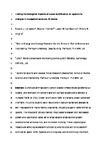Linking the biological impacts of ocean acidification on oysters to changes in ecosystem services: A review
| dc.contributor.author | Lemasson, Anaëlle | |
| dc.contributor.author | Fletcher, S | |
| dc.contributor.author | Hall-Spencer, Jason | |
| dc.contributor.author | Knights, Antony | |
| dc.date.accessioned | 2016-11-25T13:10:37Z | |
| dc.date.issued | 2017-02-21 | |
| dc.identifier.issn | 0022-0981 | |
| dc.identifier.issn | 1879-1697 | |
| dc.identifier.uri | http://hdl.handle.net/10026.1/8027 | |
| dc.description.abstract |
Continued anthropogenic carbon dioxide emissions are acidifying our oceans, and hydrogen ion concentrations in surface oceans are predicted to increase 150% by 2100. Ocean acidification (OA) is changing ocean carbonate chemistry, including causing rapid reductions in calcium carbonate availability with implications for many marine organisms, including biogenic reefs formed by oysters. The impacts of OA are marked. Adult oysters display both decreased growth and calcification rates, while larval oysters show stunted growth, developmental abnormalities, and increased mortality. These physiological impacts are affecting ecosystem functioning and the provision of ecosystem services by oyster reefs. Oysters are ecologically and economically important, providing a wide range of ecosystem services, such as improved water quality, coastlines protection, and food provision. OA has the potential to alter the delivery and the quality of the ecosystem services associated with oyster reefs, with significant ecological and economic losses. This review provides a summary of current knowledge of OA on oyster biology, but then links these impacts to potential changes to the provision of ecosystem services associated with healthy oyster reefs. | |
| dc.format.extent | 49-62 | |
| dc.language | en | |
| dc.language.iso | en | |
| dc.publisher | Elsevier BV | |
| dc.subject | Climate change | |
| dc.subject | Shellfish | |
| dc.subject | Aquaculture | |
| dc.subject | Sustainability | |
| dc.subject | Ecosystem Approach | |
| dc.title | Linking the biological impacts of ocean acidification on oysters to changes in ecosystem services: A review | |
| dc.type | journal-article | |
| dc.type | Review | |
| dc.type | Journal | |
| plymouth.author-url | https://www.webofscience.com/api/gateway?GWVersion=2&SrcApp=PARTNER_APP&SrcAuth=LinksAMR&KeyUT=WOS:000405046700005&DestLinkType=FullRecord&DestApp=ALL_WOS&UsrCustomerID=11bb513d99f797142bcfeffcc58ea008 | |
| plymouth.volume | 492 | |
| plymouth.publication-status | Published | |
| plymouth.journal | Journal of Experimental Marine Biology and Ecology | |
| dc.identifier.doi | 10.1016/j.jembe.2017.01.019 | |
| plymouth.organisational-group | /Plymouth | |
| plymouth.organisational-group | /Plymouth/Faculty of Science and Engineering | |
| plymouth.organisational-group | /Plymouth/Faculty of Science and Engineering/School of Biological and Marine Sciences | |
| plymouth.organisational-group | /Plymouth/PRIMaRE Publications | |
| plymouth.organisational-group | /Plymouth/REF 2021 Researchers by UoA | |
| plymouth.organisational-group | /Plymouth/REF 2021 Researchers by UoA/UoA07 Earth Systems and Environmental Sciences | |
| plymouth.organisational-group | /Plymouth/REF 2021 Researchers by UoA/UoA14 Geography and Environmental Studies | |
| plymouth.organisational-group | /Plymouth/Research Groups | |
| plymouth.organisational-group | /Plymouth/Research Groups/Marine Institute | |
| plymouth.organisational-group | /Plymouth/Users by role | |
| plymouth.organisational-group | /Plymouth/Users by role/Academics | |
| plymouth.organisational-group | /Plymouth/Users by role/Researchers in ResearchFish submission | |
| dcterms.dateAccepted | 2016-12-05 | |
| dc.rights.embargodate | 2018-2-21 | |
| dc.identifier.eissn | 1879-1697 | |
| dc.rights.embargoperiod | Not known | |
| rioxxterms.versionofrecord | 10.1016/j.jembe.2017.01.019 | |
| rioxxterms.licenseref.uri | http://www.rioxx.net/licenses/all-rights-reserved | |
| rioxxterms.licenseref.startdate | 2017-02-21 | |
| rioxxterms.type | Journal Article/Review |


